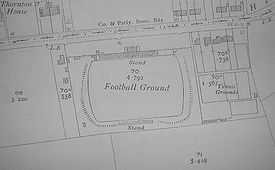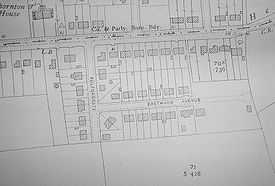Fulfordgate
| Fulfordgate | |
|---|---|
| Full name | Fulfordgate |
| Location | York, North Yorkshire,England |
| Opened | 1922 |
| Demolished | 1932 |
| Owner | York City F.C. |
| Operator | York City F.C. |
| Surface | Grass |
| Tenants | |
|
| |
Fulfordgate was a football stadium used by York City F.C. from 1922 to 1932. The ground was located in the Fulford area of York, North Yorkshire, England, next to Heslington Lane and was purchased by York for £2,000 following their formation in 1922.
The club's first two home games were played at another venue as Fulfordgate was not ready, but the ground hosted its first match against Mansfield Town in September 1922. The highest attendance at the ground was 12,721, which came against Sheffield United in an FA Cup match. York decided to move to Bootham Crescent due to Fulfordgate being relatively inaccessible, which had been vacated by York Cricket Club in 1932, and Fulfordgate was sold and developed as a building site and Eastward Avenue currently lies at the ground's former location.
History


Following York City's formation in 1922, 8 acres (3.2 ha) of land were purchased for £2,000 in Heslington Lane, Fulford, York.[1] This was in the south-east of the city in what was a rural setting, which was surrounded by hawthorn hedges and was well drained. The land was known as Gate Fulford, which was reversed to become known as Fulfordgate.[1] As the ground was not yet ready, York played their first two home games at Mille Crux, Haxby Road, which was owned by Messrs Rowntree & Company Limited.[2] The first match to be played at Fulfordgate was against Mansfield Town on 20 September 1922, which finished as a 4–1 victory for York, and only went ahead after director John Fisher paid the necessary requisite deposit of £180.[1][3] When the club applied for admission to the Football League in 1927, the league stated that Fulfordgate was "splendidly drained, well-equipped, spacious and capable of being extended to hold up to 40,000 spectators".[1] By the time York had been elected to the Football League in 1929, the stadium was estimated to be able to hold 17,000 supporters.[1] An amateur international was also held at the ground when England played Ireland in November 1931.[1]
Concern was expressed at York's poor support towards the end of their third season in the Football League and director G.W. Halliday believed the only solution was a change of ground.[1] A major problem for the club was the ground's relatively inaccessible location, and in 1932, York held preliminary discussions about moving to Bootham Crescent, which had been vacated by York Cricket Club.[4] A special meeting of the shareholders was held, which saw chairman Arthur Brown draw attention to gate receipts figures in Fulfordgate's three Football League seasons, which represented average crowds of 4,000 and a deficit on the balance sheet.[5][6] It was pointed out by Halliday that within a one mile (1.6 km) radius of Bootham Crescent the population was 30,000, whereas it was only 3,000 for a similar radius of Fulfordgate.[6] The directors were satisfied that the new ground would fulfill all requirements, although there was some opposition to the move.[6] Following much discussion, the decision was decided by a vote, which resulted in the approval of the move by 115 votes to 37.[7] The site which held Fulfordgate was sold and developed as a building estate.[7] Today, Eastward Avenue occupies the area where the ground once stood.[8]
Structure and facilities
The stadium initially had no covered stands and the dressing rooms consisted of an old army hut, but open stands were later bought from York Race Committee.[1][9] The ground was gradually built up, with improved and covered accommodation being available after two years.[1] By 1927, new turnstiles were fitted and stronger fencing was built around the pitch,[1] which reportedly made it more difficult for a spectator to surmount it and access the pitch.[9] Nine-tier terracing replaced the old banking behind one of the goals, the covered 'popular' stand was extended to hold 1,000 supporters and there was also a small seated stand.[1]
Records

The highest attendance at the stadium before York's election to the Football League was 8,318 for a match between York Boys and Brighton Boys in an English Schools' Trophy semi-final on 12 May 1928.[1] The stadium's record highest attendance was set on 14 January 1931 when 12,721 saw Sheffield United play York in an FA Cup third round replay.[1][10] The highest attendance in the Football League is 10,120 for a 2–0 defeat by Port Vale.[11] The record lowest attendance is 1,735 against New Brighton.[12]
The highest seasonal average attendance at Fulfordgate whilst York were in the Football League was 5,279 in the 1929–30 season.[13][A] The lowest seasonal average at the ground was 3,906 in the 1930–31 season.[10][B]
Transport
- Main article: York railway station
Fulfordgate was located in the south-east of York; away from the city centre.[1] It was a large distance from York railway station,[1] while the tram service to Fulford had only a single track, meaning fans found it hard to reach the ground.[14] During the ground's existence, bus routes had not been fully developed and car ownership had yet to become common; it was not easy for the majority of supporters to reach.[1]
Footnotes
- A. ^ Calculated by adding the total home attendances (110,862), then dividing by the number of home games played (21).
- B. ^ Calculated by adding the total home attendances (82,029), then dividing by the number of home games played (21).
References
- General
- Batters, Dave (1990). York City: A Complete Record 1922–1990. The Breedon Books Publishing Company Limited. ISBN 0-907969-69-0.
- Batters, David (2008). York City The Complete Record. The Breedon Books Publishing Company Limited. ISBN 978-1-85983-633-0.
- Inglis, Simon (1983). The Football Grounds of England and Wales. Collins Willow. ISBN 0-00-218024-3.
- Specific
- ↑ 1.0 1.1 1.2 1.3 1.4 1.5 1.6 1.7 1.8 1.9 1.10 1.11 1.12 1.13 1.14 1.15 Batters. York City: A Complete Record 1922–1990. p. 114.
- ↑ Batters. York City The Complete Record. p. 16.
- ↑ Batters. York City: A Complete Record 1922–1990. p. 15.
- ↑ Batters. York City: A Complete Record 1922–1990. pp. 114–116.
- ↑ Batters. York City: A Complete Record 1922–1990. p. 116.
- ↑ 6.0 6.1 6.2 Batters. York City: A Complete Record 1922–1990. p. 117.
- ↑ 7.0 7.1 Batters. York City: A Complete Record 1922–1990. p. 118.
- ↑ Inglis. The Football Grounds of England and Wales. p. 108.
- ↑ 9.0 9.1 "City Database". York City South. Retrieved 29 February 2008.
- ↑ 10.0 10.1 Batters. York City: A Complete Record 1922–1990. p. 300.
- ↑ Batters. York City The Complete Record. p. 110.
- ↑ Batters. York City: A Complete Record 1922–1990. pp. 298–302.
- ↑ Batters. York City: A Complete Record 1922–1990. p. 298.
- ↑ "York City FC: history". BBC North Yorkshire. 2 July 2007. Retrieved 29 February 2008.
| ||||||||||||||
Coordinates: 53°56′13.83″N 1°3′59.25″W / 53.9371750°N 1.0664583°W